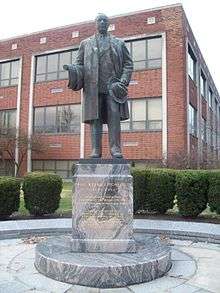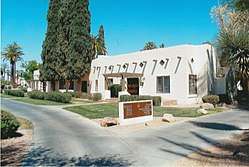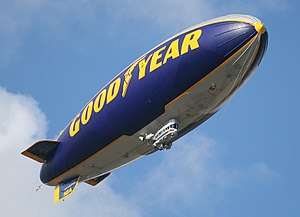Paul W. Litchfield
| Paul W. Litchfield | |
|---|---|
 Paul W. Litchfield | |
| Born |
Paul Weeks Litchfield July 26, 1875 Boston, Massachusetts, U.S. |
| Died |
March 18, 1959 (aged 83) Phoenix, Arizona, U.S. |
| Nationality | American |
| Education | Massachusetts Institute of Technology |
| Occupation | Businessman, author, inventor and founder of the City of Litchfield Park, Arizona |
| Spouse(s) | Florence Printon Litchfield |
Paul W. Litchfield (July 26, 1875 – March 18, 1959) was an American inventor, industrialist, author, CEO of the Goodyear Tire & Rubber Company and the founder of the town of Litchfield Park, Arizona. Among his accomplishments as Chairman was the establishment of a research and development department that produced the first practical airplane tire, long-haul conveyor belts, hydraulic disc brakes for airplanes, the first pneumatic truck tire, and a bullet-sealing fuel tank for military airplanes. Litchfield was also the author of books on air power, trucks, employee relations, and business.
Early years
Litchfield (birth name: Paul Weeks Litchfield) was born in Boston, Massachusetts to Charles M. Litchfield and Julia W. Litchfield. He was a direct descendant of Mayflower pilgrims.[1] He received his primary and secondary education in his native city and continued his higher education at Massachusetts Institute of Technology. In 1896, he graduated and earned a degree in chemical engineering. His first job in the rubber business was with a bicycle-tire manufacturer.[2][3][4]
Goodyear Tire & Rubber Company

Litchfield went to work for the Goodyear Tire & Rubber Company plant in Akron, Ohio. He soon became superintendent of the plant. In 1899, he designed and patented the first pneumatic wheels (tubeless tires) which were used in New York City's busses on Fifth Avenue. He became the superintendent and plant manager by 1900. In 1903, he met Florence Pennington Brinton, who worked for the Akron Beacon Journal. They were married on June 23, 1904.[5]
Under his direction, Goodyear began to experiment in the development of airplane parts. In 1910. he advocated for the establishment of an aeronautics department in the company. The company accepted his ideas and began to be involved in the production of aircraft that was lighter-than-air. The new department also produced observation balloons and after World War I, would team up with the German Luftschiffbau Zeppelin Company to produce zeppelins, and dirigibles. Some of these set size and altitude records.[2][3][6][4]
During World War I, the demand for cotton was at an all-time high in the United States. He needed strong fabric for a new tire he designed, he wanted it woven only from long cotton staple. Litchfield believed there were places in the United States where the climate and soil conditions were very similar to those of the Nile Valley in Egypt. The United States Department of Agriculture suggested that cotton could be grown in the area surrounding Phoenix, Arizona. In 1916, Litchfield went to Phoenix, but was unsuccessful.[7][2][3][6][4]
Litchfield Park
He did, however become interested in the Salt River Valley area and convinced the Goodyear company to establish the Southwest Cotton Company in Phoenix. Litchfield was named president and he purchased 36,000 acres (15,000 ha) in the general Salt River Valley area which included 5,000 acres (2,000 ha) around the present site of Litchfield Park, then known as Litchfield Ranch.[8][9][10]
Two thousand men and women, mostly Mexican migrants and Native Americans were recruited by the Southwest Cotton Company. They transformed the desert area into agricultural fields and cultivated thousands of acres of cotton fields.[8][9][10] Litchfield took an interest in the community which he established and in 1917, he established a cemetery for the employees of the Goodyear Farms and the Wigwam Resort. The cemetery was first called the "Pioneer Cemetery" and later changed to "Litchfield Cemetery". In 1918, the labor camps in Arizona were not exempt from Spanish influenza pandemic. Many of the workers of the Litchfield Ranch were affected and died. It is believed that there are approximately 1700 graves in the cemetery. Most of the graves related to those who died from the epidemic are unmarked. Eventually, other workers and their families used this cemetery.[8][9][10]

In 1918, he had the Wigwam Organizational House built by The Goodyear Tire & Rubber Company as lodging for local ranch suppliers. This was the first building of what was to become the Wigwam Hotel which opened its doors in 1929.[11] In 1919, he had the St. Thomas Mission Church a.k.a. "St. Thomas Aquinas Mission Church" built. The church was built primarily for the Mexican farm workers of the Southwest Cotton Company.[12] That same year he oversaw the construction of the Litchfield Elementary Schools. In 1920, the Litchfield Train Station, a feeder station of the Southern-Pacific Rock-Island Line, near Maricopa County 85 and Litchfield Road was established.[7]
On one occasion Litchfield was in a gambling casino in Ensenada, Mexico. He became fascinated by the interior of the casino and made a detailed drawing of it. He used it as a model for the sanctuary of the Church at Litchfield Park which was built in 1938 by the Goodyear Tire & Rubber Company crew.[13]
President of the Goodyear Tire and Rubber Company


By 1924, Litchfield was Vice President of the Goodyear Co. That same year he forged a joint venture with the German Luftschiffbau Zeppelin Company. The two companies built two Zeppelins in the United States. The Goodyear-Zeppelin Corporation was created to facilitate the relationship. In 1926, Litchfield went on to become the president of the Goodyear-Zeppelin Corporation.[14] As company president, he was responsible for the company's expansion and set up plants, factories and plantations in foreign countries such as Java, Sumatra. the Philippines and Mexico. He expanded the company's operation in South America, Europe and Africa.[2][3][6][4]
The two airships built by the Goodyear-Zeppelin Corporation were the USS Akron a.k.a "ZRS-4" and the USS Macon a.k.a. (ZRS-5). Both were designed by Chief Designer Karl Arnstein and a team of experienced German airship engineers.[15]
The construction of the USS Akron airship began on October 31, 1929 at the Goodyear Airdock in Akron, Ohio. A special hangar had to be built because this ship was larger than any other airship previously built in the United States. The airship was launched on August 8, 1931.[16][17] Construction of the USS Macon began on May 1931 and launched on March 11, 1933. Both airships were sold to the United States Department of the Navy.[18]
In 1930, Litchfield became the Chairman of the Board of the Goodyear Tire and Rubber Company, thus becoming the company's first CEO.[19] He was featured on the cover of Time Magazine on August 10, 1931, Vol. XVIII, No. 6.[20]
The partnership between the Goodyear Co. and the Luftschiffbau Zeppelin Company ended after World War II began,[21] but the American company continued to build blimps under the Goodyear name.
World War II

In 1943, he was responsible for the establishment of a research and development department in the company. The department developed various items which would be of great help to the United States military during its involvement in World War II. Among the items produced were the first practical airplane tire, long-haul conveyor belts, hydraulic disc brakes for airplanes, the first pneumatic truck tire, and a bullet-sealing fuel tank for military airplanes. The research department provided work for 250 research scientists. Under his direction the company became the 10 largest company producing aircraft and airplane parts during the war era, in the United States. It employed 37,000 workers. The company manufactured F4U Corsair fighter planes for the U.S. Military.[2][3][6][4]
Later years
Litchfield retired in 1956 and continued to live with his wife and family in his ranch "Rancho La Loma" located on a hill in the town which now bears his name. The property had four additional "cottages" for family members besides the main house. In 1958, Litchfield's health began to take a turn for the worse and he and his wife moved to a new house on Fairway Drive, close to a golf course.[22]
On March 18, 1959, Paul Weeks Litchfield died in his home. He was survived by his wife and two daughters, Katherine and Edith. Mrs. Litchfield moved to Akron, Ohio and died in 1972 at the age of 92.[23] Edith and her husband Wally Denny resided in "Rancho La Loma" until each of them died, Edith in 2001 and Wally in 2008. The Edith and Wallace Denny estate offered to the City of Litchfield Park "La Loma homestead" as a gift.[22]
Accolades
Arizona named an important avenue "Litchfield Road" in his honor[24] and Kent State University presents the Paul W. Litchfield Goodyear Scholarship to students entering the university and its regional campuses. To qualify for this award, one of the student's parents must be an employee with five or more years of service with, or a retiree of, the Goodyear Tire and Rubber Company or one of its domestic subsidiaries. The selection for this renewable award is based on the students academic records, national test scores and financial need.[25] Gadsden, Alabama honored Litchfield by naming a school, Litchfield High School, after him in 1970. This was due to the fact that in 1929, Litchfield had a plant built in Gadsden providing the people of that town with employment.[26] Litchfield Park, which was founded in 1916, was incorporated as a city in 1987.[27]
Written works
Litchfield authored various books including his autobiography Industrial Voyage which was published in 1954. The following books are among those authored by Paul W. Litchfield:
- The Industrial Republic: A Study in Industrial Economics; Publisher: Forgotten Books; ISBN 133099776X; ISBN 978-1330997765.
- Industrial Voyage; My Life as an Industrial Lieutenant; Publisher: Doubleday; First Edition edition; ASIN: B000UCJGX0.
- WHY?- WHY HAS AMERICA NO RIGID AIRSHIPS; Publisher: Corday & Gross, Columbus, Ohio; First Edition edition; ASIN: B000PDYG8O.
Further reading
See also
References
- ↑ Az Central Arts
- 1 2 3 4 5 Encyclopaedia Britannica
- 1 2 3 4 5 GREAT AMERICAN BUSINESS LEADERS OF THE 20TH CENTURY
- 1 2 3 4 5 Success Stories
- ↑ "Litchfield Park"; By: Celeste S. Crouch; Page 38; Publisher: Arcadia Publishing; ISBN 1439642400, ISBN 9781439642405
- 1 2 3 4 Goodyear History
- 1 2 Litchfield Park History
- 1 2 3 Goodyear
- 1 2 3 "Goodyear Farms historic cemetery". azcentral. Retrieved 2018-05-03.
- 1 2 3 "Pioneer Cemetery Evokes Mexican Migrant Workers Roots in Arizona". AlterNet. 2010-04-15. Retrieved 2018-05-03.
- ↑ hotels.org/hotels-resorts/the-wigwam/ Historic Hotels of America
- ↑ St. Thomas Aquinas Church
- ↑ Church at Litchfield Park
- ↑ TIME Magazine Cover Story
- ↑ Akron-Summit County Public Library, Summit Memory, Dr. Karl Arnstein photo and biography, retrieved 18 May 2018
- ↑ "Goodyear-Zeppelin Corporation, Facts About the World's Largest Airship Factory & Dock". via Akron-Summit County Public Library. Retrieved 18 May 2018.
- ↑ "A Nine Acre Nest For Dirigibles" Popular Science Monthly, September 1929
- ↑ Monterey Bay National Marine Sanctuary, Submerged Maritime Heritage Resource: USS Macon. "The Marvel of the USS Macon". Retrieved 18 May 2018.
- ↑ Goodyear History
- ↑ Cover of Time Magazine
- ↑ Goodyear-Zeppelin Corporation
- 1 2 Litchfield Legends
- ↑ New York Times MRS. PAUL LITCHFIELD
- ↑ North and south roads in the West Valley
- ↑ Paul W. Litchfield Goodyear Scholarship
- ↑ Many schools honor Gadsden’s past
- ↑ History